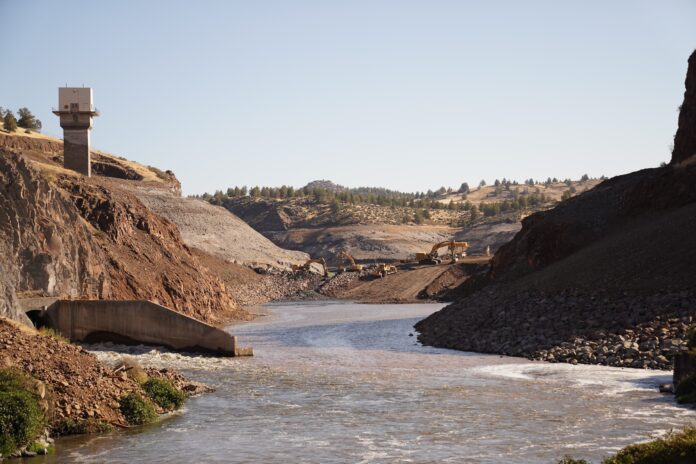
BY DAVE HURLEY
REQUA – A wall of muddy water from the removal of the final cofferdams at Iron Gate and Copco No.1 dams sites began flowing down the Klamath River on August 28, 2024, and for the first time in over 100 years, the lower Klamath will once again run free to the Pacific Ocean. The removal of four lower river dams has been a process lasting more than 20 years, and it will be several more years before the Klamath is restored to anywhere close to its natural state, but the removal of the dams has brought optimism to local tribes and the communities that have fought long and hard for their removal.
The Klamath River watershed in northern California and southern Oregon once held the third-largest run of salmon on the West Coast, but dam building and water diversions starting in 1889, dramatically changed the river’s output to one of abundance to one of deficit. The past 20 years have been particularly devastating to the salmon and steelhead runs, and the watershed moment was the September 2002 fish kill where a minimum of 33,000 and perhaps as high as 70,000 adult Chinook salmon died due to gill rot disease attributed to low flows of 760 out of Iron Gate Dam. The Klamath River Renewal Project is the largest dam removal and restoration project in U.S. history and the world’s largest salmon restoration endeavor.
The fish kill was the catalyst for the dam removal, but this took over two decades to put into reality as tribal members from nations along the Klamath started a grassroots campaign to remove the lower four Klamath River dams as a requisite step toward restoring the watershed to health. After many twists and turns and plot changes since the Bring Home the Salmon campaign began in 2004, the dam’s owner – PacifiCorp, the States of California and Oregon, Tribal governments, conservation groups, commercial and recreational fishing organizations, and local governments reached a settlement agreement in 2016 to remove the dams. n 2016, the Klamath River Renewal Corporation (KRRC), a private, independent non-profit 501(c)(3) organization, was formed with the exclusive mandate of leading the decommissioning of the dams. Additional negotiations with the the Federal Energy Regulatory Commission (FERC) were required for the final agreement for the removal of the four dams and restoration to proceed. A transfer to the Klamath River Renewal Corporation occurred in 2022, allowing the ability to proceed with the removal. Starting in September 2023, the first of the four dam removals began, culminating in the final coffer dams removed in late August.
Even though the river is now running free for over 400 miles, there is no time for resting on the laurels of completing the world’s largest dam removal as the river will take at least a decade to heal. Restoration efforts began years in advance of the dam’s coming down, and in 2019, the Klamath River Renewal Corporation awarded Resource Environmental Solutions (RES) to restore the river following the removal of the dam.
The objectives for restoration are:
- Restore and revegetate the land where the reservoirs used to be
- Reconnect the tributaries to the main river
- Monitor water quality and protected species
- Improve water quality by allowing the sediment to flow downstream naturally
The Klamath is at last flowing free due to the efforts of many willing to persevere through a winding journey through seen and unforeseen roadblocks. When the river returns to its glory days is now up to the continued efforts of man and through nature’s healing by time.



